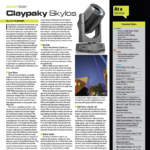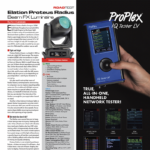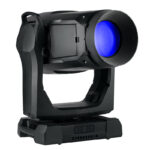Chauvet Professional has delivered an impressive fixture that can serve as a nice wash light as well as a masterful bit of eye candy. The Maverick MK Pyxis is a compact slugger with a lot of bells and whistles designed to offer the user unending colorful and dimming chase effects. Most importantly, they have come up with a system of macros that deal with dimmer chases as well as fun color combinations at the same time.
The fixture itself is built rock solid and weighs more than one would think for a fixture this size. Side handles are designed not to extend any further out than the width of the yoke. The black matte shell is made of a flame retardant polymer. The footprint of the fixture (approximately a foot wide by 18 inches high) makes it compact enough to fit in any hole in a set, club truss or storefront window. There’s a place on any big stage for a bunch of these to work and impress a client as well.
I can feed the fixture AC 100-240V through a Seetronic twist lock AC cable. The fixture draws 262 watts at 120 volts, so I could safely run a half dozen of these lights on one 20-amp circuit, especially since there’s an AC output to daisy-chain the fixtures. As is Chauvet’s way of thinking, the operator can control the fixture through any protocol they wish. There are 5 pin as well as 3 pin XLR’s for DMX. There are RJ45 in and out connectors to feed the fixture Art-Net, Kling-Net, or sACN. It is already outfitted to accept WDMX without any cables necessary.

The Source and the Color
The face of the fixture is flat, with the center occupied by a single 60-watt RGBW LED in a reflector that emits a collimated 3° beam with a soft edge. The field is relatively flat, and my meter reads 2000 lux from 30-foot distance. Surrounding the center beam is a halo consisting of nine 15-watt four color LEDs. Referred to as the ring, this module zooms in and out physically. When zoomed small, the ring extends about three inches past the center LED, which remains at a constant size. At this 5° size, the outer lights join in with the inner LED to form one large beam of light. But the ring can zoom out to an impressive 45° field angle around the center beam as well for a larger wash. The ring of light measures about 700 lux from the same distance. Combined together as one beam, I measure 2,250 lux from 30 feet away.
I am running the fixture in the highest extended mode, referred to as “touring mode.” It takes 131 channels of DMX, as I have control over four-color and a dimmer channels for each of the 10 LEDs. There are three other modes to choose from, with the minimal DMX footprint being 26 channels. The operator has the choice of running these fixtures in Single or Dual Mode. In Single Mode, DMX is used to control the entire fixture. In Dual Mode, the fixture can take signal from two different sources. This is in case the user would like to use pixel mapping, with the LEDs in each fixture accepting a video signal mapped to their position on stage.
I can easily grab the color of the whole fixture by telling fixture one to be red at full, and all the LEDs will change to that color at their highest level of output. If I wish (think basic mode), I have one separate color channel for the center LED and one for all the LEDs on the ring for quick programming. However, I still can override those colors and assign individual colors to any ring I would like. I grab the ring and put it in a multi-colored rainbow effect easily enough. I write two part chases that can execute color bumps between the LEDs in an odd/even chase, and it looks good.
There is a color wheel channel (along with a channel for time) that can be used quite effectively. Unlike faux color wheels you find with most LED fixtures, this one is well thought out. Chauvet has set it up so the various colors fade from saturated colors to lighter tones of the same blend. For instance, I set my color wheel channel at 20 percent and I have a saturated impressive blue. Move one DMX point, and I have a slightly lighter shade. This goes down until I reach the CTB range of slightly blue hues. Basically, the color wheel is reminiscent of a Roscolux swatch book, in that they group the colors in the same range, basically premixing them for you in numerical orders they have picked.
There is a separate channel for adjusting the color temperature between 2,800°-10,000°K. There are different settings to adjust the power width modulation for flicker-free camera results. There are two dimmer modes and four dimmer curves to choose from. These are set in the personality.
The Effects
Movement-wise, the fixture has the typical 540° pan and 270° tilt angles. It moves at the speed of a quick moving light, but not as fast as a small beam fixture usually does. It has separate DMX channels that enable continuous pan and tilt, and the speeds of these can be adjusted. What I found interesting was that the time it takes the fixture to snap out of this mode and go back to a preset focus was faster and smoother than most fixtures. It took half a second for me to go from a slow continuous roll to a preset position, and the fixture did not snap out of the mode in an undesirable position, then move to its designation. It underwent the transition smoothly. When in hyper-fast mode, it took .8 seconds to get there — again, smoothly.
The strobe is done electronically with Sync, Random and Pulse modes of all speeds. The duration of the strobe and the rates can be set differently for the center LED and the ring as a whole. I wasn’t sure what to make of this function until I turned off the lights and added some haze to the room. I am coming up with some pretty rad stuff here. I can write a chase that alternates the strobes so the center strobes for .5 seconds then stops, so the outside can strobe for the other half a second. It’s a pretty cosmic effect.
Programming
Programming this bad*ss fixture in touring mode is not for the inexperienced. There is a master color channel for the whole fixture. If you wish to set various cells to different color values, one must have this color channel set to zero. This is the same process with the master dimmer channel. This is just if you would like to build your own dimmer and color chases. But if you are in a hurry, use the prebuilt macros that exist in the Beam Effects section.
The macros are divided into two parts, labeled Patterns and Programs. Patterns is a whole bunch dimmer effects that pertain to the outer ring of LEDs. Programs are color as well as color and dimmer chases that are combined. There are two separate channels that adjust the speed and fade between steps of all these macro chases.
Lastly, this fixture offers something clever that I have never seen before. It’s a function called background color. In these channels, users can chose one particular base color (and level of intensity) that they would like to see every LED cell go to during an effect other than black. For instance, I may choose a macro that has the LEDs chasing intensity in the ring white flashing white at full, in every other step. Without background color on, the LEDs that aren’t going to full white will go black. If I put the background color in red at, say 50 percent intensity, they will default to that color instead of black in the macro. Very clever thinking.
At a Glance:
Rock-Solid and Feature Packed
The Pyxis delivers an incredibly fun bit of eye candy packed around a single ray of light. I imagine a rig with a dozen of these would be fun for any LD to play with. They pack a medium-sized punch as a wash fixture as well.
Maverick MK Pyxis
- PROS: Great eye candy. Good solid center beam. Fast zoom, even with a sin wave effect on it. Continuous pan and tilt. Individual control of every parameter. Great strobing capabilities.
- CONS: Serious programming skills needed for maximum use of all effects.
SPECS
- Light Source: 60 W RGBW LED (center pixel, 3° beam angle), surrounded by a ring of nine 15 W RGBW LEDs with a motorized zoom range of 7° to 45°.
- Wattage: 262W at 120V
- Color Macros and Gobos: Built-in.
- Size: 12.2” x 8.85” x 18”
- Weight: 32 lbs.
- Ratings: IP20, CE, MET
- MSRP: $2,700
Manufacturer: Chauvet Professional
More Info: www.chauvetprofessional.com



